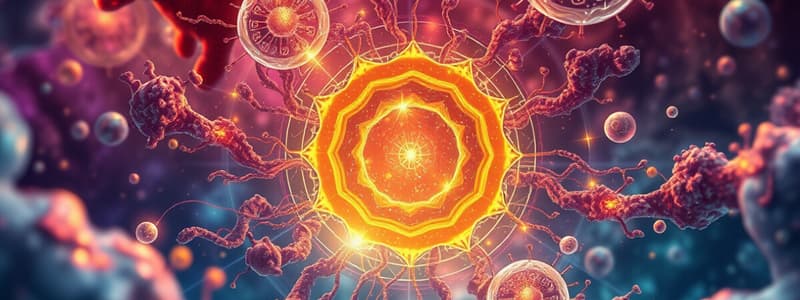Podcast
Questions and Answers
What best defines the concept of emergent properties in biological systems?
What best defines the concept of emergent properties in biological systems?
- Phenomena that do not exist in lower levels of biological organization.
- Attributes that emerge when components interact within a complex system. (correct)
- Characteristics that only manifest at higher levels of organization.
- Properties that arise from interactions at the cellular level only.
Which of the following correctly lists the biological levels of organization from simplest to most complex?
Which of the following correctly lists the biological levels of organization from simplest to most complex?
- Organisms, cells, tissues, populations, communities.
- Organisms, environments, ecosystems, biospheres.
- Atoms, molecules, cells, tissues, organ systems, organisms. (correct)
- Cells, tissues, organs, systems, populations.
In an ecosystem, which factor is primarily responsible for stabilizing interactions between different species?
In an ecosystem, which factor is primarily responsible for stabilizing interactions between different species?
- Evolutionary changes in physical traits of organisms.
- Genetic diversity within individual species.
- Predation and herbivory that balance species populations. (correct)
- Intraspecific competition for resources.
Which of the following best describes the fundamental unit of life based on cellular structure and function?
Which of the following best describes the fundamental unit of life based on cellular structure and function?
Which level of organization directly includes interactions between different populations within a defined area?
Which level of organization directly includes interactions between different populations within a defined area?
What is an example of an emergent property regarding tissue function?
What is an example of an emergent property regarding tissue function?
Which of the following levels of biological organization involves multiple types of tissues working together?
Which of the following levels of biological organization involves multiple types of tissues working together?
How does the function of a colony of ants exemplify emergent properties?
How does the function of a colony of ants exemplify emergent properties?
What is a key characteristic of the biosphere level in the hierarchy of biological organization?
What is a key characteristic of the biosphere level in the hierarchy of biological organization?
Which property distinguishes molecules formed from atoms?
Which property distinguishes molecules formed from atoms?
In terms of cell function, what role does an organ play in an organism?
In terms of cell function, what role does an organ play in an organism?
Which statement best describes the interaction of ecosystems within the biosphere?
Which statement best describes the interaction of ecosystems within the biosphere?
At which level of biological organization does digestion occur in a biological system?
At which level of biological organization does digestion occur in a biological system?
Which characteristic distinguishes prokaryotic cells from eukaryotic cells?
Which characteristic distinguishes prokaryotic cells from eukaryotic cells?
What role do tissues play in multicellular organisms?
What role do tissues play in multicellular organisms?
Which of the following options best describes an emergent property?
Which of the following options best describes an emergent property?
Which of the following statements is true regarding the levels of biological organization?
Which of the following statements is true regarding the levels of biological organization?
Which structure is not considered a part of the cellular hierarchy of life?
Which structure is not considered a part of the cellular hierarchy of life?
Why are viruses not considered living organisms?
Why are viruses not considered living organisms?
What defines the function of organelles within a cell?
What defines the function of organelles within a cell?
Which of the following statements about hierarchical classification of life is accurate?
Which of the following statements about hierarchical classification of life is accurate?
Flashcards are hidden until you start studying
Study Notes
Biological Levels of Organization
- Biological organization ranges from atoms to the biosphere, encompassing various levels such as cells, tissues, organs, and ecosystems.
- Cells are the basic structural and functional units of life; they can be unicellular or multicellular.
- Two main cell types exist: prokaryotic cells (without membrane-bound nuclei) and eukaryotic cells (with membrane-bound organelles and nuclei).
Emergent Properties
- Emergent properties arise when components at one level interact to create new properties at a higher level.
- Epithelial tissue demonstrates emergent properties by preventing mechanical injury and fluid loss due to tightly-packed cells.
- For example, individual stomach cells cannot digest food, but the stomach organ performs digestion both chemically and mechanically.
Tissue Formation
- Similar cells with common functions combine to form tissues, essential in multicellular organisms.
- Types of tissues include:
- Epithelial tissue: covers surfaces and forms protective layers.
- Muscle tissue: includes smooth and cardiac muscle, facilitating movement.
- Vascular tissue in plants: responsible for transport within the plant system.
Examples of Organization
- Levels of biological organization exemplified:
- A neuron represents the cellular level.
- A black shama is an example of an organism.
- All ecosystems on Earth showcase the biosphere level.
- A group of Cebu cinnamon trees illustrate a higher organization level based on a specific plant species.
Functionality and Life
- Cells contain organelles that sustain functions necessary for life.
- Metabolic processes that keep organisms alive occur within cells.
- Organ systems are formed from various tissues working together for specific functions, emphasizing collaboration in biological systems.
Studying That Suits You
Use AI to generate personalized quizzes and flashcards to suit your learning preferences.




